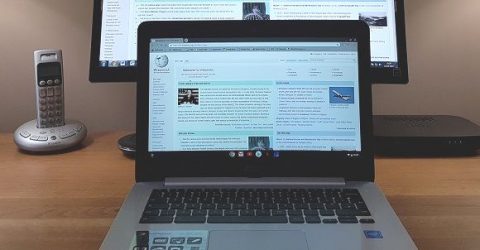Is a Chromebook a proper laptop?

Necessity is the mother of invention, which is why the mobile computing market saw several innovations at the start of this decade.
Laptops had hitherto been heavy and expensive machines, so the new wave of lightweight, battery-maximising netbooks made a great deal of sense for people constantly on the move.
Apple’s iPad was about to introduce us all to the seductive concept of tablets.
Meanwhile, Google was putting the finishing touches to its introductory range of Chromebook laptops, launched in 2011 with much fanfare.
Powered by a revised version of the open source Linux operating system, Chromebooks were initially cut-price competitors to conventional laptops.
However, Google’s decision in 2016 to make Android apps from its Play Store available on Chromebooks transformed these lightweight machines into powerful multimedia hubs.
Precious metal?
Initially, Chromebook laptops were unfavourably compared to the more powerful Microsoft Windows-powered machines which dominated the market.
However, Chromebooks were aimed at very different markets.
Laptops of the day cost up to £1,000 and bulged with battery-draining hardware and software, whereas Chromebooks were lightweight and cheap.
This made them ideal for students and schoolchildren, who would eventually become key demographics in terms of Chromebook sales.
(From Google’s perspective, this got people enmeshed in the company’s software at an early age, encouraging them to become lifelong Chrome web browser users and YouTube addicts).
Today, a Chromebook laptop costs as little as £160 while still containing an 11-inch screen, a full-size keyboard and an Intel Celeron processor.
Despite their tactile nature and impressive design, tablets can’t offer that level of day-to-day practicality.
The inevitable compromises
The first key difference between a Chromebook and a laptop is the former’s relative lack of functionality.
The operating system doesn’t take kindly to programs being installed, other than apps from the Google Play Store – though there are several million of these.
You can’t really use Chromebooks as gaming machines unless the games in question are hosted through a website interface like Steam.
Microsoft Office and Adobe CC can’t be installed, though it’s possible to use certain applications through the cloud, and Google offers its own suite of productivity tools.
Going online couldn’t be easier, but even something as basic as changing the screen background may seem unduly complicated to anyone familiar with Windows or macOS.
Don’t expect eye-popping screen quality or punchy sound output from these budget machines, though weedy speakers may be enhanced by a volume booster utility.
Case for the defence
Once you’ve accepted they’re built to a budget, Chromebooks certainly qualify as laptops – and they offer many advantages over more traditional portable computers.
Chromebooks combine the lightweight chassis and app-powered simplicity of tablets with a full-sized keyboard and conventional trackpad.
(Most Chromebooks offer peripheral ports to plug in external monitors, mice and suchlike.
However, because they’re intended to work over WiFi, it’s generally easier to hook up to wireless devices like printers and scanners.)
The cost-saving absence of CD/DVD drives is irrelevant given the evolution of online file storage and cloud-hosted software applications.
The introduction of Android apps was a literal and metaphorical game-changer, offering far more practicality than tablets could ever offer, at prices far below traditional laptops.
Rock-bottom pricing means a stolen or broken Chromebook laptop won’t be punishingly expensive to replace – ideal for younger users.
And because saved documents are stored by default in Google Drive cloud storage, important data won’t be lost even if the Chromebook itself is.






